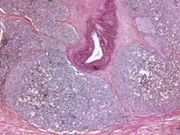MRI-based screening could reduce unnecessary biopsies, overdiagnosis of low-grade cancer
MONDAY, March 27, 2017 (HealthDay News) — Magnetic resonance imaging (MRI)-targeted biopsy could reduce the need for biopsies and overdiagnosis with low-grade prostate cancer, according to a study presented at the annual meeting of the European Association of Urology, held from March 24 to 28 in London.
Arnout Alberts, M.D., from the Erasmus Medical Center in Rotterdam, Netherlands, and colleagues compared screening using sextant transrectal ultrasound-guided biopsy (6-TRUS-Bx), 12-core TRUS biopsy (12-TRUS-Bx), and a MRI ± target biopsy (MRI ± TBx) strategy in the fifth screening round of the European Randomized Study of Screening for Prostate Cancer. Men with a prostate-specific antigen ≥3.0 ng/mL received 6-TRUS-Bx (177 men) or chose to receive a multiparametric MRI as part of the MRI side study (158 men). Participants in the side study received 12-TRUS-Bx with performance blinded for MRI results.
The researchers found that 70 percent of men in the side study had no suspicious lesions on MRI and did not receive TBx. The detection rate of high-grade prostate cancer was comparable for 6-TRUS-Bx, 12-TRUS-Bx, and MRI ± TBx (10, 12, and 11 percent, respectively). The detection rate for low-grade prostate cancer was 28 percent for 12-TRUS-Bx, which was significantly higher than 17 percent for 6-TRUS-Bx; the detection rate for MRI ± TBx was significantly lower (7 percent).
“Population-based prostate cancer screening with MRI instead of TRUS-biopsy has a significantly better risk/benefit ratio and could offer real benefits to men at risk of prostate cancer,” Alberts said in a statement.
Copyright © 2017 HealthDay. All rights reserved.








